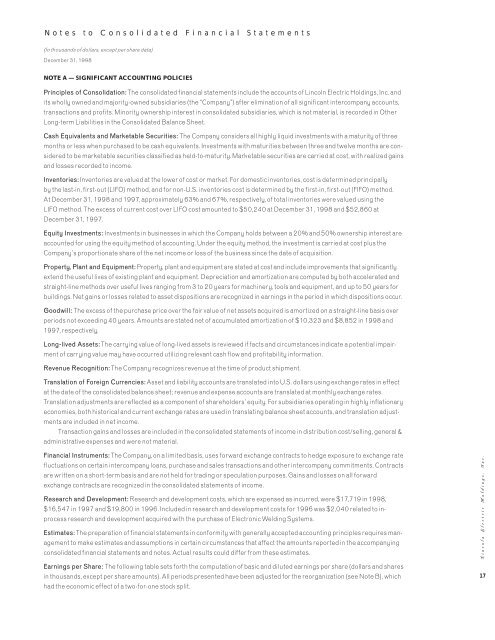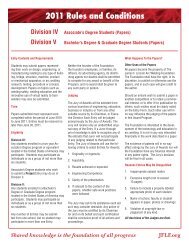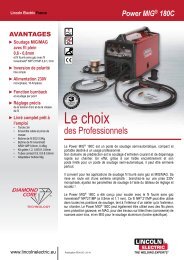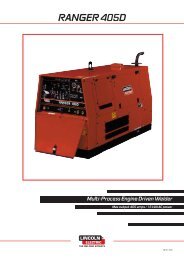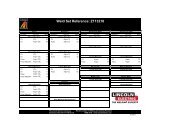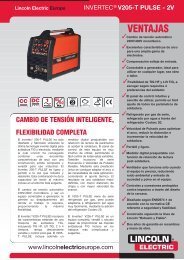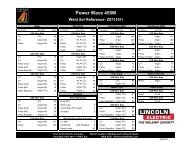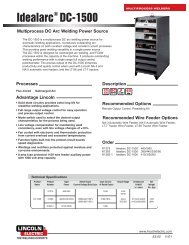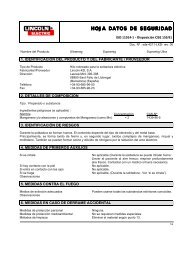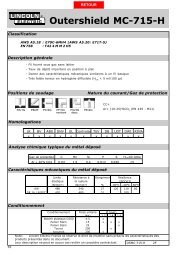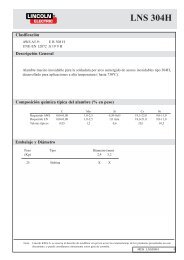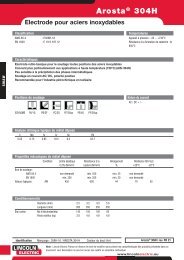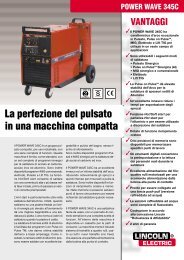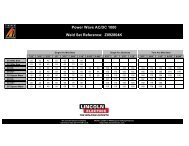Financial/Lincoln 98/watt (Page 12) - Lincoln Electric
Financial/Lincoln 98/watt (Page 12) - Lincoln Electric
Financial/Lincoln 98/watt (Page 12) - Lincoln Electric
You also want an ePaper? Increase the reach of your titles
YUMPU automatically turns print PDFs into web optimized ePapers that Google loves.
Notes to Consolidated <strong>Financial</strong> Statements<br />
(In thousands of dollars, except per share data)<br />
December 31, 19<strong>98</strong><br />
NOTE A — SIGNIFICANT ACCOUNTING POLICIES<br />
Principles of Consolidation: The consolidated financial statements include the accounts of <strong>Lincoln</strong> <strong>Electric</strong> Holdings, Inc. and<br />
its wholly owned and majority-owned subsidiaries (the “Company”) after elimination of all significant intercompany accounts,<br />
transactions and profits. Minority ownership interest in consolidated subsidiaries, which is not material, is recorded in Other<br />
Long-term Liabilities in the Consolidated Balance Sheet.<br />
Cash Equivalents and Marketable Securities: The Company considers all highly liquid investments with a maturity of three<br />
months or less when purchased to be cash equivalents. Investments with maturities between three and twelve months are considered<br />
to be marketable securities classified as held-to-maturity. Marketable securities are carried at cost, with realized gains<br />
and losses recorded to income.<br />
Inventories: Inventories are valued at the lower of cost or market. For domestic inventories, cost is determined principally<br />
by the last-in, first-out (LIFO) method, and for non-U.S. inventories cost is determined by the first-in, first-out (FIFO) method.<br />
At December 31, 19<strong>98</strong> and 1997, approximately 63% and 67%, respectively, of total inventories were valued using the<br />
LIFO method. The excess of current cost over LIFO cost amounted to $50,240 at December 31, 19<strong>98</strong> and $52,860 at<br />
December 31, 1997.<br />
Equity Investments: Investments in businesses in which the Company holds between a 20% and 50% ownership interest are<br />
accounted for using the equity method of accounting. Under the equity method, the investment is carried at cost plus the<br />
Company’s proportionate share of the net income or loss of the business since the date of acquisition.<br />
Property, Plant and Equipment: Property, plant and equipment are stated at cost and include improvements that significantly<br />
extend the useful lives of existing plant and equipment. Depreciation and amortization are computed by both accelerated and<br />
straight-line methods over useful lives ranging from 3 to 20 years for machinery, tools and equipment, and up to 50 years for<br />
buildings. Net gains or losses related to asset dispositions are recognized in earnings in the period in which dispositions occur.<br />
Goodwill: The excess of the purchase price over the fair value of net assets acquired is amortized on a straight-line basis over<br />
periods not exceeding 40 years. Amounts are stated net of accumulated amortization of $10,323 and $8,852 in 19<strong>98</strong> and<br />
1997, respectively.<br />
Long-lived Assets: The carrying value of long-lived assets is reviewed if facts and circumstances indicate a potential impairment<br />
of carrying value may have occurred utilizing relevant cash flow and profitability information.<br />
Revenue Recognition: The Company recognizes revenue at the time of product shipment.<br />
Translation of Foreign Currencies: Asset and liability accounts are translated into U.S. dollars using exchange rates in effect<br />
at the date of the consolidated balance sheet; revenue and expense accounts are translated at monthly exchange rates.<br />
Translation adjustments are reflected as a component of shareholders’ equity. For subsidiaries operating in highly inflationary<br />
economies, both historical and current exchange rates are used in translating balance sheet accounts, and translation adjustments<br />
are included in net income.<br />
Transaction gains and losses are included in the consolidated statements of income in distribution cost/selling, general &<br />
administrative expenses and were not material.<br />
<strong>Financial</strong> Instruments: The Company, on a limited basis, uses forward exchange contracts to hedge exposure to exchange rate<br />
fluctuations on certain intercompany loans, purchase and sales transactions and other intercompany commitments. Contracts<br />
are written on a short-term basis and are not held for trading or speculation purposes. Gains and losses on all forward<br />
exchange contracts are recognized in the consolidated statements of income.<br />
Research and Development: Research and development costs, which are expensed as incurred, were $17,719 in 19<strong>98</strong>,<br />
$16,547 in 1997 and $19,800 in 1996. Included in research and development costs for 1996 was $2,040 related to inprocess<br />
research and development acquired with the purchase of Electronic Welding Systems.<br />
Estimates: The preparation of financial statements in conformity with generally accepted accounting principles requires management<br />
to make estimates and assumptions in certain circumstances that affect the amounts reported in the accompanying<br />
consolidated financial statements and notes. Actual results could differ from these estimates.<br />
Earnings per Share: The following table sets forth the computation of basic and diluted earnings per share (dollars and shares<br />
in thousands, except per share amounts). All periods presented have been adjusted for the reorganization (see Note B), which<br />
had the economic effect of a two-for-one stock split.<br />
<strong>Lincoln</strong> <strong>Electric</strong> Holdings, Inc.<br />
17


